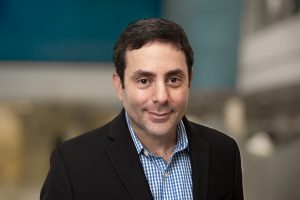
Seattle Children’s is getting set to launch a program that will redefine how we care for children with “high-risk” leukemia – or leukemia that doesn’t respond well to standard treatments and/or has relapsed after therapy.
Unfortunately, less than 40% of children with high-risk leukemia will live for more than four years after they’re diagnosed. Our new High-Risk Leukemia Program aims to cure more of these children by uniting their doctors onto one team, and by using state-of-the-art diagnostic tests to match kids with the latest treatments and clinical trials. The program will also partner with researchers to pursue new treatments and cures.
The first-of-its-kind program is expected to attract patients and families from across the country, and it’s being led by Dr. Todd Cooper as part of his lifelong mission to improve care for children with high-risk leukemia. On the Pulse sat down with Cooper to learn about how the new program will transform care and bring new hope to children and families.
Why do we need a new approach against high-risk leukemia?
We’ve made tremendous progress against leukemia, but too many children still relapse – including about half of children with acute myeloid leukemia and about 15% of children with acute lymphoid leukemia. Most of these kids relapse because they don’t respond well to standard chemotherapy and, unfortunately, they have a much higher risk of dying from their disease.
The good news is, there are some really promising new ways to diagnose and treat high-risk leukemia, and some great ideas on how to reshape the process of caring for these children. We think that bringing all these new approaches into one clinic will give today’s kids a better chance to survive, and set the stage for discoveries and new treatments that will help many more kids in the future.
How will the new clinic improve the experience of patients and families?
The first thing families will notice is that we bring all their care under one roof. Instead of having to go to different clinics to see different specialists on different days, they’re going to see everyone they need on their first visit. This team of world-renowned experts will include oncologists, bone marrow transplant specialists and – depending on the particular child – experts in infectious disease, cardiology, radiation oncology and several other areas. This is going to be a whole lot more convenient for families.
This team approach means we can see patients from every angle, and put our heads together and come up with the best possible treatment plan. All the specialists will work together throughout each step of the patient’s care, so we can keep close track of their condition and change treatments if necessary. That means each patient will get the best possible care throughout their entire treatment journey.
What will be different about the actual treatments?
The clinic will take a “precision medicine” approach that starts with improving how we diagnose these kids. For example, every child who comes through our doors is going to have their cancer genetically sequenced. This will let us identify the mutations that drive each patient’s leukemia, so we can understand what’s different about it and why it’s so hard to treat.
Then, instead of one-size-fits-all drugs, we’ll do our best to match kids with therapies that target their particular cancer’s weaknesses. It’s a much more tailored way to treat high-risk leukemia, and it could help many more kids achieve remission.
Every child we see in our clinic will also have access to a wide variety of novel therapies, including the innovative T-cell immunotherapies being developed at the Ben Towne Center for Childhood Cancer Research and Fred Hutch.
What role will clinical trials and research play?
They’re both integral. Since standard treatments don’t work very well for high-risk leukemia, most of our patients will join clinical trials of new therapies. At Seattle Children’s, we’re fortunate to have some of the nation’s top experts and leaders in cancer clinical trials, and a long track record of guiding kids through them.
These experts will be part of the team that evaluates patients when they first come to the clinic. This will help us match kids with therapies that have the best chance of being effective.
The clinic will also help researchers improve these therapies and develop new ones. We expect to attract a critical mass of families from around the world who want to be sure their child gets the best possible care. This will give us access to an unprecedented amount of information about high-risk leukemia – we’ll be able to gather samples and key information about each patient’s cancer. Then we’ll work with our research partners to mine that information, so we can better understand high-risk leukemia, figure out where it’s vulnerable and find new ways to attack it.
I think this will lead to a new era of childhood cancer treatment. We’re realizing that childhood leukemia is different from adult leukemia, but all the therapies we use are based on adult therapies. Our research is going to help create therapies that are designed for children, tailored to individual patients, and hopefully much more effective.
Why did you devote your career to studying high-risk leukemia and helping kids overcome it?
We’ve saved a lot of children, but I’ve also seen the devastation that cancer has on kids and their families. I never stop thinking about the children we couldn’t save, and it makes me incredibly motivated to find better ways to help our patients. I want every parent to know that, if they bring their child here, we’ll leave no stone unturned and we won’t rest until we find the path that gives them the best chance at a happy, healthy life.
Resources:
- Cancer and Blood Disorders Center

